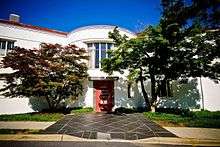Morris Cafritz
Morris Cafritz (c. 1888 - June 13, 1964) was a Washington, D.C. real estate developer, and philanthropist.
Morris Cafritz | |
|---|---|
| Born | 1888 Lithuania |
| Died | June 13, 1964, 77 years old |
| Known for | Real estate development and Philanthropy in Washington, D.C. |
| Spouse(s) | Gwendolyn Detre de Surany |
| Children | Calvin Cafritz Carter Cafritz Conrad Cafritz |
| Relatives | Julia Cafritz (granddaughter) Peggy Cooper Cafritz (daughter-in-law) |
Early life and education
Cafritz was born to a Jewish family in Lithuania.[1] Based on papers filed in court, Cafrtiz was born in 1888; however, the year of his birth is not known and Cafritz had often understated his age.[2] Along with his 4 siblings, he immigrated to the United States in 1898. After briefly settling in New York, the family moved to Washington and operated a small grocery store on 24th and P Streets NW.[2] Cafritz scouted the Maine Avenue Fish Market for fish for the store and sold newspapers on 15th Street, near the United States Department of the Treasury.[2][3] At the age of 19, he studied at the National University School of Law before realizing that he wanted to be in business, not law.[3] Cafritz began his business career in 1904 by buying the Star Coal and Coke Company, at 315 Q Street, with a $1,400 loan from his father.[2][4] In 1911, he owned a saloon, the Old-Timer's Bar, at 8th Street and K Street, Southeast, Washington, D.C.[3] He also acquired bowling alleys and by 1915, he was known as Washington's "bowling king".[4][2]
Real estate development career

In 1916, he began developing two-story row-houses.[3] In 1922, he founded Cafritz Construction and acquired a large tract of land for $700,000, which he financed with a down payment of $35,000; he eventually built 3,000 houses on the site.[4] The first phase included 53 rowhouses in Petworth, which he sold for $8,950 each.[3][5]
He developed the Greenwich Forest neighborhood in Bethesda, Maryland.[6] He built the now-demolished Ambassador Hotel, at 14th and K Street.[2] In 1932, he led the group that constructed the Westchester Apartments, at which Barry Goldwater resided.[4] The same year, Cafritz built homes in the neighborhood next to the National Arboretum.[7] Cafritz built the Majestic Apartments.[2] In 1938, he built his residence, a mansion at 2301 Foxhall Road, N.W.[5][2] In 1949, he built the Cafritz Building, at 1625 Eye Street.[5] He developed several office buildings along K Street, including 1725 K, 1725 I, and 1735 I Streets.[5][2]
Until the passage of the 1968 Fair Housing Act, Cafritz used racially restrictive covenants to exclude African Americans and other racial minorities. He advertised the whites-only Greenwich Forest neighborhood as "rigidly exclusive with protective restrictions."[8]
Death
Cafritz died in 1964 of a heart attack. When he died, his estate was the largest ever probated in the District of Columbia. It took lawyers and IRS agents 4 years to settle the estate, which was valued in 1968 at $66 million.[2]
Philanthropy
He raised $250,000 to build the Washington, D.C. Jewish Community Center, of which he was a charter member and president.[3]
In 1964, he offered to donate the Chase's Theater and Riggs Building as a performing arts center.[3]
The Morris Cafritz Center for the Arts at the DC Jewish Community Center is named for him.[9]
Morris and Gwendolyn Cafritz Foundation
Cafritz founded the Morris and Gwendolyn Cafritz Foundation in 1948, funding it with $11.5 million.[3] The foundation is the largest private foundation focused on Washington, D.C. It gives annual charitable grants of $20 million to nonprofit organizations in the Washington, D.C. area. It has given over $500 million since inception. The foundation awards the Distinguished DC Government Employees Award to individuals who exemplify the best in public service.[10]
Family
In July 1929, Cafritz married Gwendolyn Detre de Surany, twenty years his junior. She was daughter of Roman Catholic Hungarian immunologist Dr Laszlo Detre de Surany, co-discoverer of the Wassermann test for syphilis, who settled at Washington in the 1920s and became chief immunologist for the United States Public Health Service.[11][12] They had 3 children: Calvin, Carter and Conrad.[2][13][14] His son Conrad married Peggy Cooper Cafritz. When Gwendolyn died in 1988, her instructions to leave her entire estate to the foundation was challenged by her children, who were already all multimillionaires.[2]
His granddaughter is musician and guitarist Julia Cafritz.[15] Their home was located on Foxhall Road and is now The Field School.[13]
References
- Jewish Washington: "Real Estate Boom" retrieved September 18. 2014
- Williams, Marjorie (February 25, 1990). "CAFRITZ V. CAFRITZ". The Washington Post.
- Ozer, Mark N. (March 3, 2010). Massachusetts Avenue in the Gilded Age: Palaces & Privilege. Arcadia Publishing. ISBN 9781614236436.
- "Morris Cafritz, Builder, Dead". The New York Times. June 13, 1964.(subscription required)
- Solomon, Burt (June 29, 2010). The Washington Century: Three Families and the Shaping of the Nation's Capital. HarperCollins. ISBN 9780062013743.
- Maryland Historical Trust Inventory No. M:35-165 Maryland Inventory of Historic Properties Form (PDF).
- "Cafritz Project Visited By Many: Prospective Home Buyers Are Much Attracted to Randolph Place". The Washington Post. April 10, 1932. p. R1.
- "5 marks Jewish developers made on Montgomery County". Washington Jewish Week. Retrieved 2019-12-15.
- "Center for the Arts".
- "Cafritz Awards Returns to Celebrate Outstanding DC Government Employees".
- https://www.nytimes.com/1972/02/20/archives/carfer-deire-cairifz-is-fiance-of-miss-mary-melissa-berfholi.html
- https://www.washingtonpost.com/archive/local/1988/11/30/dc-hostess-gwendolyn-cafritz-dies/1ce03124-db68-459f-85c9-61d0d94ac47c
- Anderson, Susan Heller (December 1, 1988). "Gwendolyn Cafritz, 78, Washington Hostess". The New York Times.
- Williams, Marjorie (March 31, 2007). The Woman at the Washington Zoo: Writings on Politics, Family, and Fate. PublicAffairs. p. 18. ISBN 9781586485412.
But Gwendolyn sometimes took pains to tell her friends that she herself was not Jewish
- https://www.washingtonpost.com/archive/lifestyle/magazine/1990/02/25/cafritz-v-cafritz/9f486a14-9672-4802-802e-0e470a9f1507